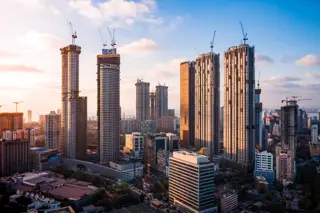 Surat's commercial real estate market is growing fast, driven by its role as a diamond and textile hub. Investors looking for steady returns now have access to REITs (Real Estate Investment Trusts), which allow fractional ownership in premium office spaces and diversified portfolios. This article explores Surat’s market potential, REIT benefits, and a roadmap for strategic investments.
Surat's commercial real estate market is growing fast, driven by its role as a diamond and textile hub. Investors looking for steady returns now have access to REITs (Real Estate Investment Trusts), which allow fractional ownership in premium office spaces and diversified portfolios. This article explores Surat’s market potential, REIT benefits, and a roadmap for strategic investments.
Surat’s Economic Boom: A Commercial Real Estate Powerhouse
Surat is set to become the world’s fastest-growing city by 2035, with a thriving industrial ecosystem. As India’s diamond capital, it processes over 80% of global diamonds, and its textile and synthetic industries further cement its commercial dominance. With strong infrastructure and proximity to Mumbai, Surat attracts global corporations and startups, creating sustained demand for office and retail spaces.
Key Growth Drivers:
- High-Grade Infrastructure: Prime connectivity via highways and upcoming development projects enhance business accessibility.
- Industrial Clusters: Areas like Vesu and Navsari host clusters of textile, plastic, and engineering industries, driving commercial property demand.
- Regulatory Support: RERA-compliant projects ensure transparency, aligning with SEBI’s REIT guidelines.
REITs: Demystifying Fractional Ownership
REITs allow investors to own stakes in income-generating commercial properties without buying properties directly. For those looking at micro to mid-sized investments, REITs offer:
- Entry Thresholds: Minimum investments as low as ₹10 lakh in platforms like Strata SM REIT.
- Diversified Portfolios: Exposure to multiple asset classes (offices, logistics, retail) within a single REIT framework.
- Tax Efficiency: SEBI-regulated structures ensure compliance with income redistribution models.
Why Office Assets Dominate REIT Portfolios
Indian REITs heavily invest in Grade-A office spaces, driven by post-pandemic demand for flexible, technology-integrated workspaces. Surat’s office market benefits from:
- Tier 1 & 2 Demand: Multinational companies and IT hubs expanding into secondary cities for cost efficiency.
- High Occupancy Rates: Stable rental yields, averaging 7-8% annual returns, supported by long-term corporate leases.
- Rent Escalation Clauses: Built-in price adjustments in tenant contracts, offering inflation hedging.
Step-by-Step REIT Investment Guide
To optimize returns in Surat’s REIT landscape, follow this strategic framework:
Research REIT Offerings:
- Analyze fund focus areas (e.g., Strata Horizon REIT emphasizes Grade-A offices in Bengaluru, with potential Surat expansion).
- Cross-check SEBI disclosures for tenant profiles and occupancy rates.
Leverage Diversification:
- Allocate investments across REITs specializing in offices, logistics, and retail to mitigate sector-specific risks.
- Consider regional diversification, pairing Surat-focused assets with Delhi-Mumbai portfolios.
Evaluate Market Fundamentals:
- Prioritize REITs with strong tenant covenants (e.g., blue-chip corporations, government institutions).
- Infrastructure upgrade in Surat such as metro and port expansion, which catalyze commercial growth.
The Future of Surat’s REIT Ecosystem
As India’s REIT market expands beyond $10 billion, Surat is poised to capture a larger share. With 24% growth in commercial projects registered in Gujarat, the city’s transition into a smart urban centre will further boost demand for office spaces. For risk-averse investors, REITs offer a tangible pathway to partake in this growth trajectory with lower capital barriers and professional asset management.
By aligning with growth hotspots like Surat and utilizing REIT structures, investors can balance portfolio stability with access to high-growth commercial real estate markets.